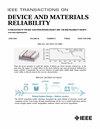Evaluation of BTI Lifetime for MOSFETs in 55 nm CMOS Node by 1/f Noise Performance Degradation
IF 2.3
3区 工程技术
Q2 ENGINEERING, ELECTRICAL & ELECTRONIC
IEEE Transactions on Device and Materials Reliability
Pub Date : 2025-07-28
DOI:10.1109/TDMR.2025.3593375
引用次数: 0
Abstract
In this study, the bias temperature instability (BTI) degradation of Si p- and n-MOSFETs fabricated using a 55 nm CMOS process was systematically and quantitatively investigated over stress time基于1/f噪声性能退化的55 nm CMOS节点mosfet BTI寿命评估
在本研究中,系统和定量地研究了用55 nm CMOS工艺制备的Si - p-和n- mosfet在应力时间$(T_{应力})$上的偏置温度不稳定性(BTI)退化。该分析侧重于关键参数,包括阈值电压漂移$(\Delta V_{th})$、亚阈值摆幅衰减($\Delta $ SS) $、最大跨导减小($\Delta Gm_{max}$)$、线性区域电流减小$(\Delta I_{dlin})$和1/f噪声性能退化。通过考察这些参数与T_{应力}$的相关性,评估了相应的BTI在弱BTI应力下的寿命。研究发现,通过1/f噪声评估BTI寿命对Si - p- mosfet和n- mosfet分别只需要35秒和50秒。此外,将不同T_{应力}$下退化数据的预测寿命与实际BTI寿命(p- mosfet为2550 s, n- mosfet为2200 s)进行比较,发现1/f噪声方法是最快和最准确的方法。这是由于其在对数-对数尺度上优于$T_{应力}$的线性和退化幅度。这些发现有助于提出一种新的方法来获得关于1/f噪声退化的mosfet的BTI寿命,特别是在模拟/混合信号(AMS)和射频(RF)应用中。
本文章由计算机程序翻译,如有差异,请以英文原文为准。
求助全文
约1分钟内获得全文
求助全文
来源期刊

IEEE Transactions on Device and Materials Reliability
工程技术-工程:电子与电气
CiteScore
4.80
自引率
5.00%
发文量
71
审稿时长
6-12 weeks
期刊介绍:
The scope of the publication includes, but is not limited to Reliability of: Devices, Materials, Processes, Interfaces, Integrated Microsystems (including MEMS & Sensors), Transistors, Technology (CMOS, BiCMOS, etc.), Integrated Circuits (IC, SSI, MSI, LSI, ULSI, ELSI, etc.), Thin Film Transistor Applications. The measurement and understanding of the reliability of such entities at each phase, from the concept stage through research and development and into manufacturing scale-up, provides the overall database on the reliability of the devices, materials, processes, package and other necessities for the successful introduction of a product to market. This reliability database is the foundation for a quality product, which meets customer expectation. A product so developed has high reliability. High quality will be achieved because product weaknesses will have been found (root cause analysis) and designed out of the final product. This process of ever increasing reliability and quality will result in a superior product. In the end, reliability and quality are not one thing; but in a sense everything, which can be or has to be done to guarantee that the product successfully performs in the field under customer conditions. Our goal is to capture these advances. An additional objective is to focus cross fertilized communication in the state of the art of reliability of electronic materials and devices and provide fundamental understanding of basic phenomena that affect reliability. In addition, the publication is a forum for interdisciplinary studies on reliability. An overall goal is to provide leading edge/state of the art information, which is critically relevant to the creation of reliable products.
 求助内容:
求助内容: 应助结果提醒方式:
应助结果提醒方式:


